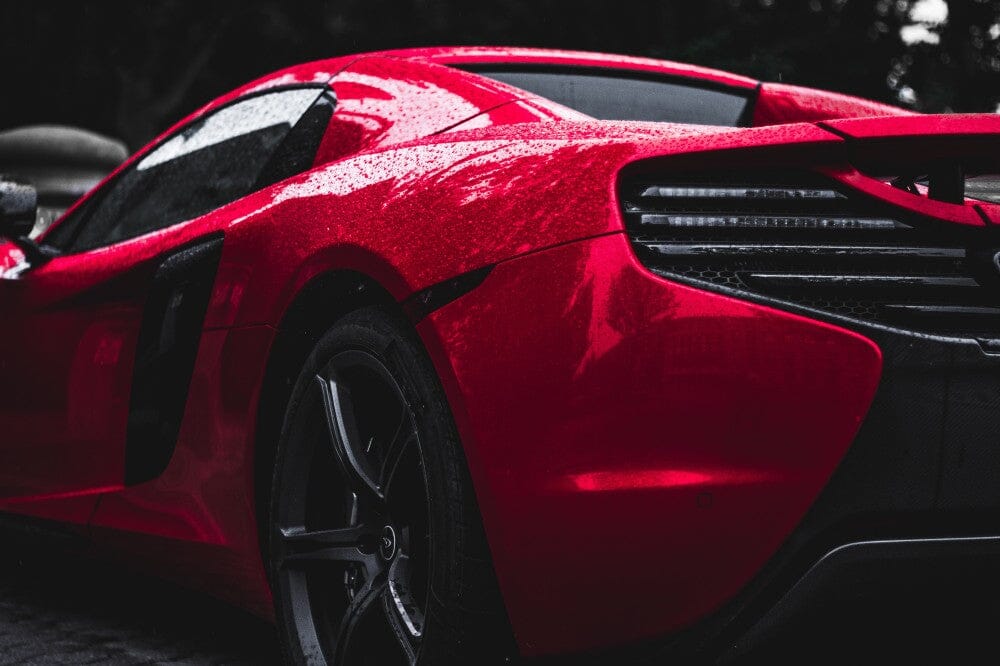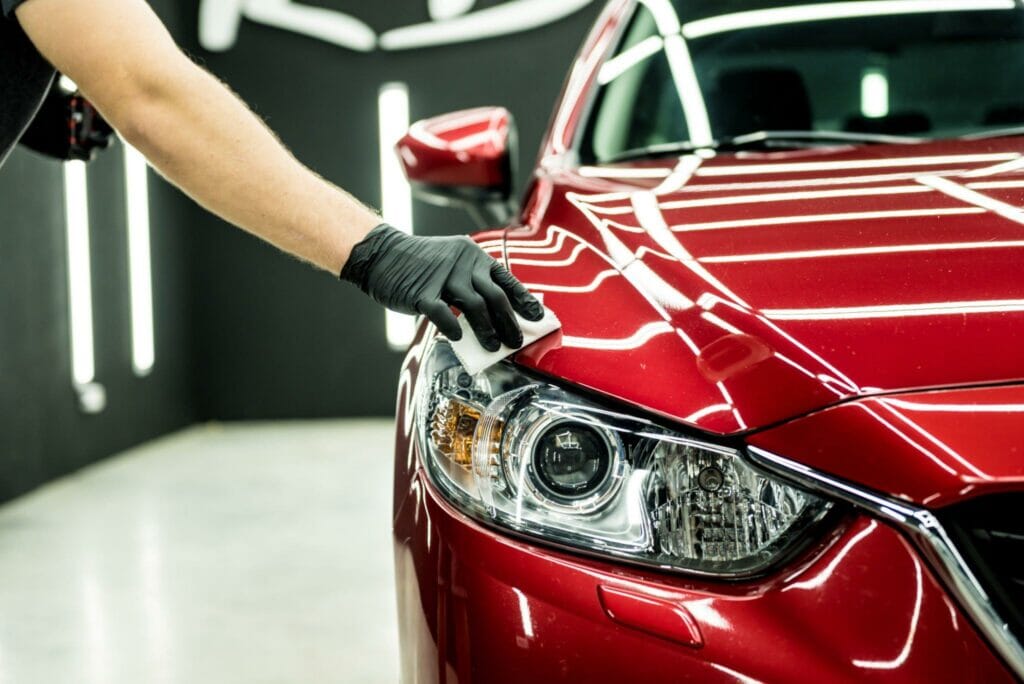There’s nothing as frustrating as stepping back from your freshly-washed car and seeing hard water spots staining the surface. You go through all that hard work, and your car still looks dirty. Luckily, there are ways to get rid of hard water spots so you can have a sparkling clean car.
★★★★★
Works on Paint, Glass & Rims
Featuring a carefully formulated acid based formula, our Water Spot Remover gets rid of stubborn calcium, mineral and fluoride deposits that cause hard water spots. The acid quickly breaks down the contaminants and allows for easy removal.
How Do Cars Get Hard Water Spots

Hard water spots result from contaminant-laden water air-drying on your car, leaving the contaminants behind as the water evaporates. These contaminants include calcium, magnesium, industrial emissions, lead, and more. Any of these compounds can cause significant damage to your car’s finish if left for too long.
Though they look similar, there are two types of hard water spots depending on where the water came from. Mineral deposits from hard water come from your plumbing, like that used to wash your car, or from a sprinkler system. Chemical etching comes from rain with different kinds of acidic gasses dissolved in it that can cause your paint to deteriorate.
Getting Hard Water Spots Off Your Car
Hard water spots are unsightly and frustrating, but they aren’t impossible to remove. You should always start with a good car wash to remove the looser contaminants, then focus on getting rid of the more stubborn hard water spots.
The Tried and True: A Dedicated Water Spot Removal Product

A commercial spot remover is a simple yet powerful tool for removing hard water spots. They’re not too expensive and will work better than anything else. Every product has a slightly different formulation, but they all have a distilled water base with mineral oil added as a lubricant. They may also contain solvents, buffers, and conditioners.
We’ve perfected our own formula that that removes water spots completely. Simple enough, it’s named Torque Detail Water Spot Remover.
The first step which is very recommended is to give the area of the water spot (or your whole car) a basic soap and water wash. After that, dry off the area of the water spot. After that, grab a clean microfiber towel and spray some Water Spot Remover on it. Rub it onto your water spot very gently. Only let it sit for 30 seconds max. Clean off the product with water or a mixture of car soap and water. Repeat these steps as many times as needed to fully remove the water spot.
Here’s another tip. Protect your newly cleaned paint with a Graphene Coating. It’ll last up to one year, give your car a gorgeous shine, and repel water from sitting still and causing another water spot.
★★★★★
Works on Paint, Glass & Rims
Featuring a carefully formulated acid based formula, our Water Spot Remover gets rid of stubborn calcium, mineral and fluoride deposits that cause hard water spots. The acid quickly breaks down the contaminants and allows for easy removal.
Vinegar and Water

Vinegar works well on hard water spots made up of mineral deposits because of its acidic nature. However, you want to dilute it with water before using it on your car to prevent it from damaging your finish instead of cleaning it.
To dilute, simply mix 2 parts of distilled water with 1 part vinegar in a spray bottle and spray it on the hard water spots, focusing on one area at a time. Gently rub the spots with a soft cloth, letting older stays soak longer, then rinse your car. Make sure to dry it thoroughly to prevent new spots from forming.
Baking Soda and Water

Baking soda acts as a mild abrasive as well as a base and can work for most water spots as long as they aren’t too deep. Mix the baking soda with some water to form a paste, adding a few drops of vinegar if you need a stronger solution. Rub the paste on the hard water spots, let it sit for 15 minutes, then rinse and dry the area. You can repeat this process if the spot still remains.
Clay Bar Method

The clay bar method is a step up from the previously discussed methods. It’s most effective when used on a car with a wax coating, sealant, ceramic coating, or nano-ceramic coating applied, but it can pull mineral deposits out of high spots. You’ll need something stronger for stains stuck in the pores of the finish.
Using a clay bar is simple. First, get the car’s surface wet and soapy, then gently rub your clay bar over it. Be sure to fold your clay bar to a new surface whenever you see contaminants on the existing surface.
Wheel Cleaning Acid

When nothing else can get those tough spots out, it’s time to break out the big guns. We don’t recommend this to most people that aren’t experienced detailers and know how to be careful with the chemicals. This is just another tool to have in your tool box.
Wheel cleaning acid contains hydrofluoric acid, a highly corrosive compound that removes brake dust from wheels. Remember, it is important to only use these products in well-ventilated areas with full protective equipment, including gloves, goggles, and a respirator, to protect yourself from the toxic gasses it releases when it reacts to mineral deposits.
In addition to protecting yourself, you must be very careful when using wheel cleaning acid on your car. Mix it into a 1:4 dilution with water and test it in an inconspicuous area to ensure it isn’t too aggressive. It is also unsafe to use on bare metal as it will quickly eat through it.
Once you’ve taken all the necessary precautions, spray the solution on a microfiber towel and quickly work it into the hard water spots. Leave it for a few seconds, then dry it and rinse the panel thoroughly. While this will do a good job of removing hard water spots, it can also eat through your clear coat and paint down to the metal if used incorrectly.
Compounding and Polishing

While the wheel cleaning acid should take care of even the most stubborn mineral deposits if they’ve sat too long or your car’s been exposed to acid rain, there may be small etchings or micro-cavities left behind. These low spots collect water and other contaminants, creating a vicious cycle of worsening damage.
If that’s the case, you’ll need to compound and polish the surface to smooth out those etchings and cavities. Finally, in the most extreme scenario, the affected panel may need to be sanded down and have the clear coat reapplied at a professional detail shop.
★★★★★
Works on Paint, Glass & Rims
Featuring a carefully formulated acid based formula, our Water Spot Remover gets rid of stubborn calcium, mineral and fluoride deposits that cause hard water spots. The acid quickly breaks down the contaminants and allows for easy removal.
Preventing Hard Water Spots On Your Car
While you can often remove hard water spots pretty easily, it’s still better to prevent them from forming in the first place, especially since they can cause a lot of damage if not addressed quickly.
The best way to prevent these spots is by applying a coating to create a protective layer between your car’s finish and the environment. This includes using options like wax, polymer paint sealants, and ceramic coatings that are easy to clean and replace without damaging your clear coat.
These coatings aren’t perfect, and you should still minimize exposure to hard water and acid rain. Garages are a great way of keeping your car out of the elements, but they aren’t always available. When you can’t park in a covered area, avoid parking near sprinklers and other sources of water that may spray on your car.
It’s also a good idea to always wash your car anytime it rains to remove any corrosive acids or contaminants before they cause too much damage. Once you wash it, dry your car thoroughly to remove minerals, acids, and contaminants while they are still dissolved in the water. By following these steps carefully, you can minimize the build-up of contaminants that lead to hard water spots.









